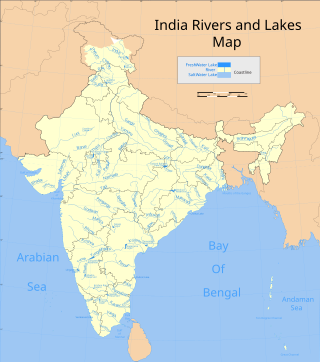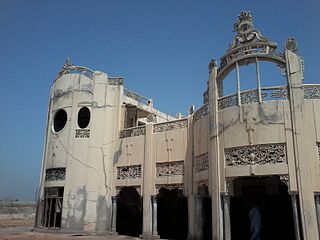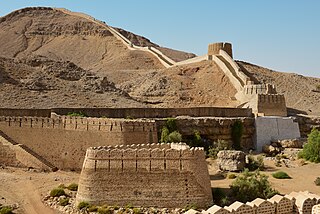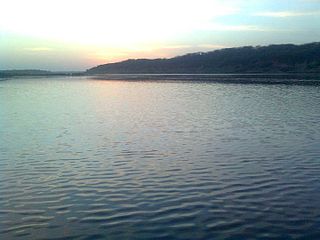Related Research Articles

Sindh is a province of Pakistan. Located in the southeastern region of the country, Sindh is the third-largest province of Pakistan by land area and the second-largest province by population after Punjab. It is bordered by the Pakistani provinces of Balochistan to the west and north-west and Punjab to the north. It shares an International border with the Indian states of Gujarat and Rajasthan to the east; it is also bounded by the Arabian Sea to the south. Sindh's landscape consists mostly of alluvial plains flanking the Indus River, the Thar Desert in the eastern portion of the province along the international border with India, and the Kirthar Mountains in the western portion of the province.

Sindhis are an Indo-Aryan ethnolinguistic group who speak the Sindhi language and are native to the Sindh province of Pakistan. The historical homeland of Sindhis is bordered by the southeastern part of Balochistan, the Bahawalpur region of Punjab and the Kutch region of Gujarat. Having been isolated throughout history unlike its neighbours, Sindhi culture has preserved its own uniqueness.

The Kali Sindh, is a river in Madhya Pradesh and Rajasthan in northern India. It is a tributary of the Chambal River in the Ganges Basin. The main tributaries of the Kali Sindh are the Parwan, Niwaj and Ahu rivers. The Kali Sindh River drains a major portion of the Malwa region, and is the biggest river flowing in the Malwa region of Madhya Pradesh.

Parvati River is a river in Madhya Pradesh and Rajasthan, India that flows into the Chambal River. The river rises at a height of 610 m in the Vindhya range in Sehore district Madhya Pradesh And flows in Sehore District, Rajgarh District, Guna District of Madhya Pradesh and then enters in Rajasthan and flows from Baran District and Sawai Madhopur District of Rajasthan where it falls into Chambal River in Sawai Madhopur District and runs for 436 km. It is one of the Chambal River's three main tributaries, along with the Banas River and the Kali Sindh River. Ramgarh crater is located on its eastern bank. Many small villages and tribes are situated on its bank, which utilise it for various purposes, such as irrigation, drinking, washing, etc.

Parbati River is a river in Madhya Pradesh and Rajasthan, India that flows into the Chambal River. The river rises at a height of 610 m in the Vindhya range in Sehore district Madhya Pradesh And flows in Sehore District, Rajgarh District, Guna District of Madhya Pradesh and then enters in Rajasthan and flows from Baran District and Sawai Madhopur District of Rajasthan where it falls into Chambal River in Sawai Madhopur District and runs for 436 km. It is one of the Chambal River's three main tributaries, along with the Banas River and the Kali Sindh River. Ramgarh crater is located on its eastern bank.

Guna district is one of the 52 districts of Madhya Pradesh in central India. Its administrative headquarters is Guna. The district has a population of 1,241,519. It has an area of 6390 km², and is bounded on the northeast by Shivpuri District, on the east by Ashoknagar District, on the southeast by Vidisha District, on the southwest by Rajgarh District, on the west and northwest by Jhalawar and Baran districts of Rajasthan state. The Sindh River flows northward along the eastern edge of the district, forming part of the boundary with Ashoknagar District, and the Parvati River flows northwestward through the southern portion of the district, forming part of the boundary with Baran District before flowing into Rajasthan.
The Gabol is a Baloch tribe having a distinct identity through the centuries, and not a branch of any other Baloch tribe. During the reign of Mir Jalal Khan, the Gabol joined the Rind Federation. Eventually, they joined Mir Chakar Khan Rind as an ally against the Lasharis.
The Kirthar Mountains are a mountain range that mark the boundary between the Pakistani provinces of Balochistan and Sindh, and which comprise much of the Kirthar National Park. The mountain range forms part of the Kirthar-Sulaiman geological province, which stretches from the Arabian Sea coast north to the Sulaiman Mountains in northwest Pakistan. The highest peak of the mountains is Zardak Peak at 7,430 ft (2,260 m).

Baran district is a district in the Indian state of Rajasthan. The headquarters of the district are located at the city of Baran.

Kashmore District, previously known as Khizmer or Khizmore, is a district of the province of Sindh, Pakistan. The capital city is Kandhkot. The district has a population of 1,090,336. Kashmore District is a part of Larkana Division. Its old name was Khizmer or Khizmor. The spoken languages are Sindhi and Balochi. Its border is connected with Punjab and Balochistan provinces. Kashmore city is gateway to Punjab province and Balochistan province. In 2004, Kashmore became a district after its separation from Jacobabad District.

Jamshoro District, is a district of Sindh province, Pakistan. Jamshoro city is the capital while Kotri is the largest city of the Jamshoro District. The district borders Dadu district to the north. To the east, the Indus separates it from Nawab Shah, Matyari and Hyderabad districts. Thatta district lies to the south, and Karachi district to the south west. To the west, the Kheerthar Range separates it from the Sindh and Lasbela district of Baluchistan.
Khan Bahadur Allah Bakhsh Gabol was a political leader of the 20th century and an exponent of the Pakistan Movement from Sindh. Allah Bakhsh Gabol was the son of a landlord Khudadad Khan Gabol, and the grandfather of Sardar Nabil Ahmed Gabol, who is a notable politician and nawab of Gabol tribe.
Nabil Gabol is a Pakistani politician who was a member of the National Assembly of Pakistan from 2002 to 2015 and a member of the Provincial Assembly of Sindh from 1988 to 1990 and again from 1993 to 1996. He served as Minister of State for Ports and Shipping from 2008 to 2011 and as Deputy Speaker of the Sindh Assembly from 1993 to 1996. Additionally, he’s the incumbent Chief Sardar (Nawab) of the Gabol, baloch tribe.
Gulshan-e-Sheraz is one of the neighbourhoods of Gadap Town in Karachi, Sindh, Pakistan.

Baldara is a town in western India in Antah Tehsil in the state of Rajasthan. It is the administrative headquarters of the Gram Panchayat. As of the 2011 census, Baldara had a population of 3,198 people; 1,635 males and 1,563 females. The expected Baldara population in 2021-2022 is between 3,134 and 3,582 people. The literate population of the town is 2,097; 1,220 of which are males and 877 females. People living in Baldara depend on multiple skills. There are 1,409 workers, 221 cultivators, dependent on farming, and 160 people working in agriculture as laborers in Baldara, totaling to 1,790 people.
Shergarh is a town in Jamshoro District, Sindh, Pakistan.

NA-240 Karachi South-I is a constituency for the National Assembly of Pakistan that encompasses Lyari.

NA-248 Karachi Central-II is a constituency for the National Assembly of Pakistan.
Parban River originates in Madhya Pradesh and flows through Rajasthan. It is a tributary of the Kali Sindh. Parban/Parvan originates in Sehore district of Madhya Pradesh and flows through Sehore, Shajapur and Rajgarh districts in Madhya Pradesh. It also flows through Jhalawar, Kota, Baran districts of Rajasthan. Before it joins the Kali Sindh it cuts a 10 km long valley of significant depth right across Ratibar Dungar near Akawad Kalan in Jhalawar district. It meets Kali Sindh in Baran district of Rajasthan. Shergarh wildlife Sanctuary situated at the bank of Parban river in Baran district.
Kareem Bux Gabol is a Pakistani politician who has been a member of the Provincial Assembly of Sindh since August 2018.
References
- ↑ "KARACHI: Sindh govt plans to build small dams". DAWN.COM. 2006-06-15. Retrieved 2019-07-24.
- ↑ Sindhwildlife.com.pk Archived March 30, 2009, at the Wayback Machine
- ↑ Gulfoilandgas.com